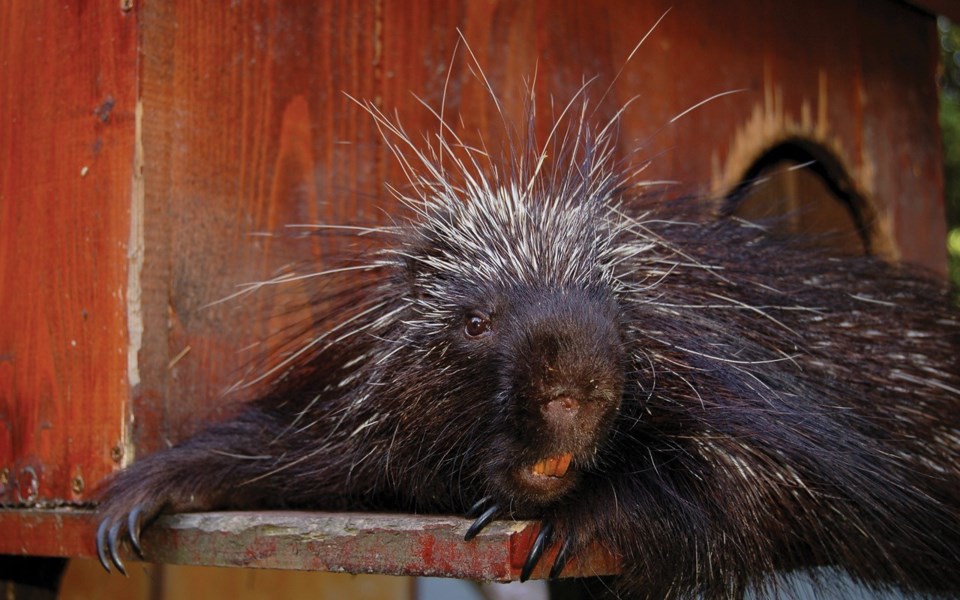In spring, with everything awakening across B.C.'s mountainscapes, I often think first about creatures I've had spring encounters with over the years. One in particular always comes to mind.
Many April's ago, I was awakened deep in the night by a hellish cacophony. My dog stood on the bed howling, and from outside came the hollow, metronomic rasp of what sounded like someone sawing into the cabin in which I slept. I instinctively grabbed an axe, flipped on the outside lights and cautiously opened the front door. There on the porch, oblivious to the light, my swearing, even the dog—whose head now protruded between my legs—was an enormous porcupine, its long, curved claws hooked into the log wall as it methodically planed the lower tiers with yellowed teeth. Shoving the dog back inside, I'd closed the door and, maintaining proper person-to-quill distance, gently tossed a boot toward what was clearly a full-grown specimen of Canada's second-largest rodent (the beaver wins this title). That was enough to dissuade it, and the short-legged, heavy-bodied animal waddled off into the darkness.
The sight I faced next morning has greeted many a horrified Canadian chalet or cottage owner—the unmistakable tooth-trails of Erethizon dorsatum had lain bare the underlying wood along much of the outside wall to a height of about 60 centimetres, as well as up and down the wooden post supporting the porch roof. The mess would require extensive sanding and refinishing to rectify, and it was small consolation to know that had I not intervened, the creature would have returned again and again until it had exhausted all accessible gnawing opportunities. What's responsible for such un-endearing behaviour in this otherwise endearing denizen of B.C.'s sub-alpine coniferous forests? Even if porcupines aren't too common in Whistler, I had to know.
Porcupines are known for their strange habits. Porcupine foreplay, for instance, isn't for the faint of heart. After a male and female circle each other performing a little moaning/nuzzling song and dance, things get kinky. The male showers the female with urine until she's soaked, at which point she lifts her tail and lets the male mount with her quills pointed elsewhere.
But I digress: what I found out about their cabin-gnawing habits actually made sense. Like deer, porcupines are browsers, feeding almost exclusively on buds, shoots, twigs, and the inner bark of trees, all of which have a high oil content. Also like deer and other herbivores, porcupines love and actively seek out salt; when a stash is found, it's mined repeatedly. Coincidentally, many wood preservatives contain high concentrations of both tree oils and mineral salts, so wooden structures treated with these represent easy treats—particularly in late winter and early spring when all that's left to chow on in the forest are conifer needles and bark. Untreated woods like cedar that contain high concentrations of natural preservatives are also targets.
Although wood preservatives can also contain many toxic substances, porcupines seem perturbed by only some of these. While they're known to chew on creosote fence posts, they won't go for the copper-chromated arsenic salts used in pressure-treated lumber (that's the green stuff employed for docks and decks). Porcupines might not realize there isn't much nutritive value in houses, but they're tenacious when they find something they like—which also explains freakish reports of these animals gnawing on the starter-cords of outboard motors, chainsaws and snowmobiles, tool handles (likely salty from human sweat), and the exposed radiator hoses of cars on which road salt accumulates over the winter. Fair enough, but what can be done to prevent porcupines from foraging on your home?
Some people sprinkle moth balls around "appetizing" wooden structures as a deterrent, but the naphthalene from which these are made is hazardous to all forms of life (including humans) and isn't something you want lingering in the soil around a dwelling. In addition, mothball vapours are mostly ineffective outdoors, where they're too weak to bother a hungry or determined animal.
A good organic alternative is to employ a liberal sprinkling of cayenne pepper on the wood surface or painted on in a strong water solution. A drawback of this measure is that it has to be replaced after every rain, and so while it may be good for solving an acute problem when you're not around, it can't be counted on to work over the course of a winter or early spring. Random noise from a motion-detector-triggered source can make life uncomfortable for porcupines but has a similar effect on your neighbour. One sure solution is to encircle buildings with unsupported chicken wire than porcupines are too heavy to climb. Some people try distractions like placing a large salt block on their property a good distance from a building, though this will also attract all manner of other animals—some of which may be even more unwelcome. In the end, it might be best just to keep an old boot by the door.
Leslie Anthony is a Whistler-based author, editor, biologist and bon vivant who has never met a mountain he didn't like.




